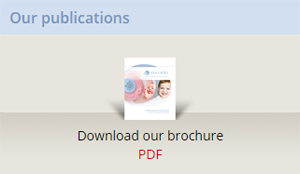Laparoscopic diagnosis of peritoneal endometriosis is usually made with the observation of typical black or blue lesions. However, there is also a significant number of atypical signs of peritoneal endometriosis that where histologically documented and described in 1986 (Donnez, Jansen, Russell). The identification of these atypical lesions increased the rates of diagnosing endometriosis from 15% in 1986 to 65% in 1988 according to the previously mentioned researchers.

B. Peritoneal endometriosis – Typical black lesion in the Vesicouterine Pouch (laparoscopic image).
C. Peritoneal endometriosis – Typical black lesion in the Vesicouterine Pouch (laparoscopic image).
The ectopic endometrial tissue behaves as the normal endometrium during menstruation, with the manifestation of small bleeding. In the peritoneum, the ectopic endometrium creates characteristic lesions that may be typical or atypical. Typical black lesions derive from bleeding of the tissue and blood encapsulation. Histologically they are made up from glands, stroma and intraluminal debris.

B. Combination of typical and subtle lesions (laparoscopic image).
Γ. Combination of white lesions, hyper-vascularity and peritoneal absence (laparoscopic image).
Subtle lesions
Sometimes, the subtle lesions are the only laparoscopic findings. Subtle lesions are more common and may be more active than the typical black lesions. According to the colour that they have, subtle lesions may are distinguished in red and white ones.
The red lesions include:
- red flame-like lesions, (Jansen RPS & Russell P., 1986),
- glandular excrescenses, (Jansen RPS & Russell P., 1986),
- areas of petechial peritoneum, (Donnez J. & Nisolle M., 1988),
- areas with hyper-vascularity, (Donnez J. & Nisolle M., 1988).
The white lesions include:
- white opacification, (Jansen RPS & Russell P., 1986),
- subovarian adhesions, (Jansen RPS & Russell P., 1986),
- cafè au lait (yellow-brown) peritoneal patches, (Jansen RPS & Russell P., 1986),
- circular peritoneal defects, (Chatman D.L., 1981).
The black forms are the typical black lesions. The presence of trapped menstruation is responsible for the typical black appearance.
Histological findings
In the typical lesions, endometrial glands and stroma were found (which are characteristic histological findings in endometriosis) in 76% of the cases. In the subtle lesions, endometriosis was confirmed (Jansen & Russell, 1986) in 81% of the white opacifications, 81% of red flame-like lesions, 67% of glandular excrescenses, 50% of ovarian adhesions, 47% of cafè au lait (yellow-brown) peritoneal patches and 45% of peritoneal defects.
































